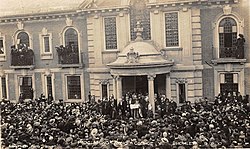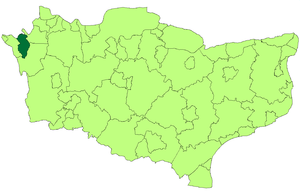History
Incorporation
The town was granted a charter of incorporation to become a municipal borough in 1903. The granting of the charter was celebrated by a public holiday in the town on 2 September 1903. The charter was brought by train to Bromley South station where it was handed to the charter mayor. The mayor then rode in procession led by units of the Royal Horse Artillery and the Royal West Kent Regiment, accompanied by mayors and mace bearers of boroughs in Kent and the County of London and watched by an estimated crowd of 20,000. A sports day and carnival was held at Queen's Mead. [5]
Under the charter a town council consisting of a mayor, six aldermen and eighteen councillors replaced the UDC. [6]
The council was initially based at the old Town Hall in the Market Square but moved to a new Town Hall in Tweedy Road in 1907. [7]
Coat of arms
Armorial bearings were granted to the borough by the College of Arms on 19 April 1904. The blazon was as follows: [12]
Quarterly gules and azure, on a fesse wavy argent three ravens volant paroper, between in the first quarter two branches of broom slipped of the third, in the second a sun in splendour, in the third an escallop shell or, and in the fourth a horse forcene argent. Crest: On a wreath of the colours, upon two bars wavy azure and argent, an escallop shell as in the arms, between two branches of broom proper.
The sprigs of broom were in allusion to the name "Bromley". The silver wave bearing three ravens represented the River Ravensbourne, while the sun was for Sundridge. The scallop shell was derived from the arms of the diocese of Rochester, granted the manor of Bromley at the time of King Ethelbert. The arms were completed by a white rearing horse, the emblem of Kent. [13]
The Latin motto adopted by the council was Dum Cresco Spero or "While I grow I hope".
This page is based on this
Wikipedia article Text is available under the
CC BY-SA 4.0 license; additional terms may apply.
Images, videos and audio are available under their respective licenses.



